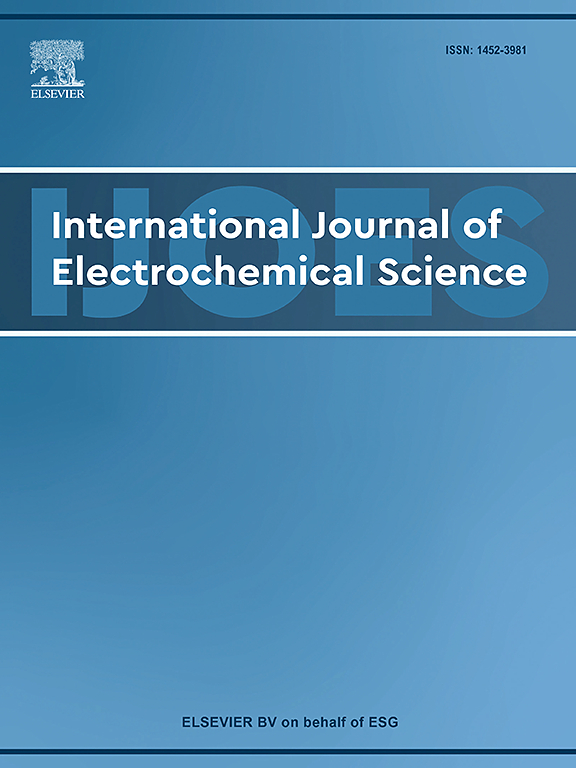流速对3.5 %氯化钠溶液中碳钢和316 L不锈钢耐电化学腐蚀性能的影响
IF 2.4
4区 化学
Q4 ELECTROCHEMISTRY
International Journal of Electrochemical Science
Pub Date : 2025-07-22
DOI:10.1016/j.ijoes.2025.101130
引用次数: 0
摘要
为了研究20#碳钢和316 L不锈钢在3.5 % NaCl腐蚀溶液中的电化学耐蚀性,建立了一种新型旋转腐蚀实验装置。采用电化学测试与计算流体力学(CFD)模拟相结合的方法,研究了流速对腐蚀溶液中钢基体电化学耐蚀性的影响。通过电化学腐蚀试验,包括开路电位、电化学阻抗谱和极化测量,评估了材料在不同流速下的腐蚀行为。结果表明:20#碳钢的腐蚀产物形成疏松多孔结构,而316 L不锈钢的腐蚀产物表面保持光滑,具有较好的耐蚀性。此外,20#碳钢和316 L不锈钢的腐蚀速率与流速呈非线性关系,存在明显的临界流速。其中,20#碳钢和316 L不锈钢的临界流速分别为2 m/s和1.5 ~ 2 m/s。在达到临界流速之前,整体腐蚀速率随流速的增加而降低。然而,超过这个阈值,由于保护腐蚀产物膜的局部击穿,腐蚀速率增加。此外,CFD模拟研究了流体动力因素,结果表明,流体诱导的剪切应力大小与腐蚀速率没有明显的正相关关系。本文章由计算机程序翻译,如有差异,请以英文原文为准。
Influence of flow velocity on electrochemical corrosion resistance of carbon steel and 316 L stainless steels in 3.5 % sodium chloride solution
A newly designed rotating corrosion experimental setup was constructed to study the electrochemical corrosion resistance of 20# carbon steel and 316 L stainless steels in 3.5 % NaCl corrosive solution combining electrochemical measurements and surface analysis techniques. The effect of flow velocity on the electrochemical corrosion resistance of steel substrates in corrosive solution was investigated using a combination of electrochemical testing and computational fluid dynamics (CFD) simulation. The electrochemical corrosion tests, including open circuit potential, electrochemical impedance spectroscopy, and polarization measurements, were conducted to assess the corrosion behavior of the materials under different flow velocities. The results revealed that the corrosion products on 20# carbon steel formed a loose and porous structure, whereas the surface of 316 L stainless steel remained smooth, exhibiting significantly good corrosion resistance. Moreover, the corrosion rates of 20# carbon steel and 316 L stainless steel exhibit a nonlinear dependence on flow velocity, with a distinct critical flow velocity identified. Specifically, the critical flow velocities for 20# carbon steel and 316 L stainless steel were 2 m/s and 1.5–2 m/s. Prior to reaching the critical flow velocity, the overall corrosion rate decreased as flow velocity increased. However, beyond this threshold, the corrosion rate increased due to the localized breakdown of the protective corrosion product film. In addition, CFD simulations were conducted to investigate the hydrodynamic factors, and the results showed that the magnitude of fluid-induced shear stress did not exhibit a clear positive correlation with the corrosion rate.
求助全文
通过发布文献求助,成功后即可免费获取论文全文。
去求助
来源期刊
CiteScore
3.00
自引率
20.00%
发文量
714
审稿时长
2.6 months
期刊介绍:
International Journal of Electrochemical Science is a peer-reviewed, open access journal that publishes original research articles, short communications as well as review articles in all areas of electrochemistry: Scope - Theoretical and Computational Electrochemistry - Processes on Electrodes - Electroanalytical Chemistry and Sensor Science - Corrosion - Electrochemical Energy Conversion and Storage - Electrochemical Engineering - Coatings - Electrochemical Synthesis - Bioelectrochemistry - Molecular Electrochemistry

 求助内容:
求助内容: 应助结果提醒方式:
应助结果提醒方式:


